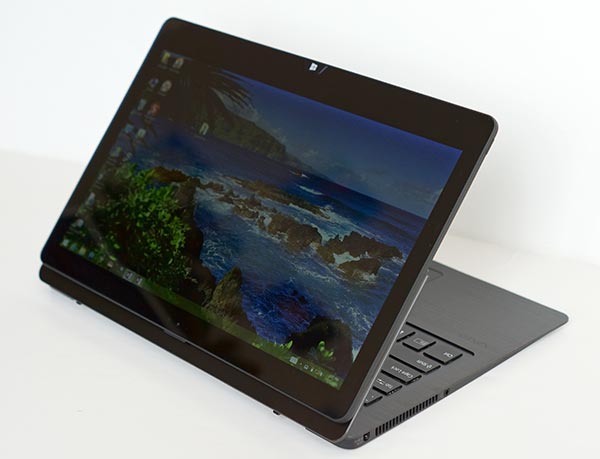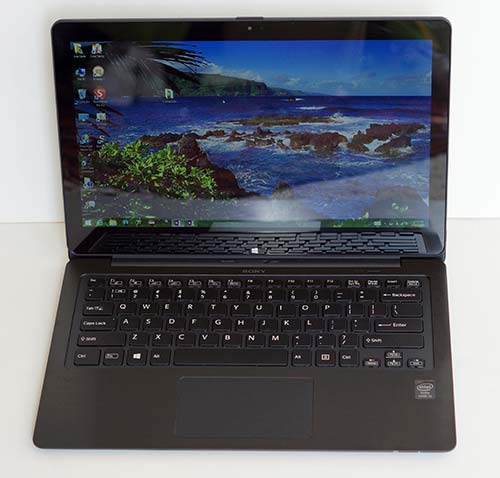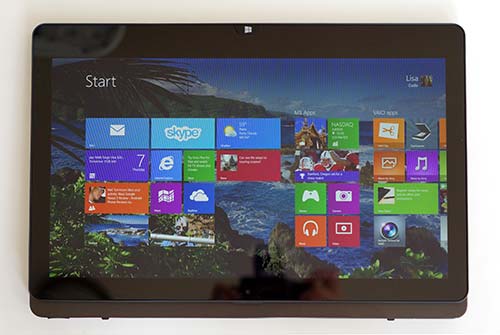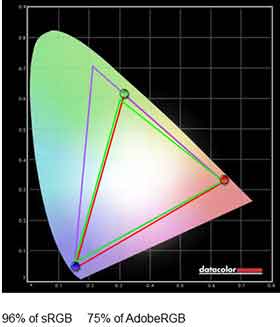Sony Vaio Flip 13 Review
11:34
Sony's not afraid to take chances with design, and we love them for that reason. The Sony Vaio Duo 11 Windows 8 convertible slider was bold but a little complex in terms of hinge design, so Sony refined it with the Vaio Duo 13.
Now they've got the Sony Vaio Flip in your choice of 3 sizes. Smart
move since some folks want ultraportables while others crave a bigger
display. We look at the Flip 13, a 13.3" Windows 8 64 bit convertible
with Ultrabook specs that include an SSD. The 14 and 15 inch Flips come
with conventional spinning hard drives, though you can order them with
SSDs. If you're interested in the 15.5" model, be sure to check out our
reivew of the Sony Vaio Flip 15.

Design and Build Quality
The Sony Vaio Flip 13 has the cleanest
and most unusual hinge design we've ever seen. The display portion's
aluminum back panel has a visible split and this is where the machine
does its transformation from laptop to presentation mode to tablet. It's
a better design than the Lenovo Yoga 13 and Yoga 2 Pro
whose keyboards face down to rest on the table or your legs in
presentation and tablet modes. At 2.89 lbs. the Flip 13 is also bearable
to use as a tablet. With the 4.32 lb. Flip 14 and 5.05 lb. Vaio Flip 15, you'll likely rest the Vaio on the table or your leg rather than hold it for extended periods of time.
Build quality is superb with no uneven
seams, no creaks or ugly hinges. Though the display back plate is very
slim, the hinge is actually very firm so there's no display bounce when
you use the touch screen. Magnets hold the screen in any of 3 positions
and the whole thing feels solid despite the thin ribbon cable tucked
safely inside. The lid and keyboard deck are made of brushed aluminum
(your choice of black or silver) and the machine looks svelte, modern
and classy. The bottom is plastic, which we actually don't mind since it
doesn't feel cold against the legs. Plastic doesn't get as hot as
metal, so the bottom of the Vaio never gets beyond warm.

The Flip 13 is an elegant and classy
looking laptop and we appreciate the more rigid and elegant looking
aluminum that Sony used this time rather than their signature flexible
carbon fiber. Unlike the Sony Vaio Pro 13,
the Flip has very little flex and pressing the trackpad doesn't cause a
sympathetic dip in the Ultrabook's underside as it does on the Pro 13
(which in all fairness is even thinner at the front edge). The sides
have an interesting design: the keyboard deck extends beyond the sides.
It looks interesting and provides grip points, but that small ledge
might get in the way of bulkier USB accessories like 3G/4G modems. More
likely, the fact that the two USB 3.0 ports are so close together will
be an issue if you use both ports at once with devices that have bulky
connectors.
Stereo speakers fire from the sides, and
after an audio driver update from the Vaio update program, they went
from meek to bold. They're loud by Sony standards (Sony laptop speakers
are oddly quiet) and stereo separation is good. Bass isn't great
however, so at high volumes, the speakers can sound shrill.
Ports, Keyboard and Trackpad
The Sony Vaio Flip 13 matches the Duo 13
and Vaio Pro 13 for ports: two USB 3.0, full size HDMI, 3.5mm combo
audio and an SDXC/Memory Stick card slot (an SD card will not protrude
from the slot). The 14 and 15 Flip models add a gigabit Ethernet RJ45
port. Sony changed the charger's tip so the Flip 13 charger isn't
interchangeable with the Vaio Duo or Pro chargers. The charger is
otherwise the same as with other Sony Ultrabooks: small and light with a
USB port for charging your smartphone or tablet. All models have NFC,
Intel N-7260 802.11n dual band WiFi (a more stable adapter than Intel's
802.11ac adapter used in the Sony Vaio Pro) and Bluetooth 4.0 + HS.
There's a front 720p webcam and a surprisingly capable rear 8 megapixel
camera with EXMOR sensor on the back.

The large Elan trackpad has a slightly
rough texture and it worked quite well for single and multi-touch
gestures. We did notice occasional cursor jumping when holding the mouse
button down and dragging a finger across the trackpad to move a file or
highlight text. Like most trackpads today, this is a buttonless model,
which means that the buttons are concealed under a unified trackpad
surface.
The keyboard has typical Ultrabook
shallow travel, but tactile feel is excellent and I had no trouble
typing out several reviews efficiently. The keys make enough noise to
provide auditory feedback without being overly loud and key damping is
good. If you're a hard-handed typist you might flex the keyboard a
little bit, but I didn't have trouble with it in the least. The keyboard
is backlit and is controlled by the ambient light sensor. There's no
way to change backlight levels on the keyboard, and it's a fairly bright
white that rings each key and illuminates the letters.
Full HD Triluminos Display
This is the same excellent Sony
Triluminos IPS display with quantum dot technology found on the Duo 13.
The 1920 x 1080 panel has 300 nits of brightness (you may need to
disable Windows 8's auto-brightness feature to reach 300 nits), 700:1
contrast (excellent) and wide color gamut. Like the Vaio Duo 13 and Vaio
Pro 13, the panel achieves 95% of sRGB and 75% of Adobe RGB, making it a
good choice for graphics professionals and one of the widest color
gamut displays available in a laptop. Even if you don't work with photos
and video for a living, you'll appreciate the rich, saturated and vivid
colors when watching movies; it really is a stunning display. Viewing
angles on IPS displays are very wide, and the Flip 13 has good but not
the best viewing angles we've seen on IPS displays. It does have wider
viewing angles than the Duo 13, but it's not as wide as the Samsung ATIV Book 9 Plus
(PLS) or 13" Retina MacBook Pro (IPS). In competition with the ATIV
Book 9 Plus, the Sony makes up for that by reproducing yellows more
accurately than the Samsung whose yellows turn mustard when the machine
is unplugged from AC. But the 9 Plus fights back with an insanely high
3200 x 1600 resolution display.

All Flip models, regardless of
size have at least 1920 x 1080 displays. If you get the 15" model,
there's a $300 2880 x 1620 option that should look very sweet. The Flip
15 with NVIDIA GT735M dedicated graphics, pen included and the higher
display resolution gets pricey though, and Sony's preconfigured model
sells for $1,799. That configuration does include a Core i7-4500U 1.8GHz
dual core CPU, 16 gigs of RAM and a 5400 RPM terabyte HDD with 16 gig
solid state boot drive, so it's a very well appointed machine. There's a
15 Flip for $1,249 stocked at Best Buy that has the Core i7, dedicated
graphics, 8 gigs of RAM and a 1920 x 1080 display.
N-Trig Active Digitizer and Pen
All Flip models come with an
active digitizer made by N-Trig. Sony's used N-Trig on their Duo models
and the Flip works the same. One point of confusion: the pen isn't
included with most SKUs, you'll have to pay $40 to get one from Sony
(it's the same pen as used on the Vaio Duo 13, and it uses N-Trig
DuoSense 2 technology). Generally if a tablet has an active digitizer
the pen is included in the box, and I'm sure this will confuse some
folks, or they might not even realize they can use a digital pen.
As ever, with N-Trig you get
accurate tracking and 256 levels of pressure sensitivity. Though the
pressure sensitivity doesn't compare well with Wacom's 1024 levels, this
is something only artists would notice. Even then, 256 levels are
enough to do advanced artwork even if I personally do prefer more levels
for nuanced art work. N-Trig's pen tip tracking is better than Wacom's,
especially near the edges of the screen where Wacom equipped
convertibles and tablets tend to be off. You have to hold the pen closer
to the display compared to Wacom, and that may be off-putting those
accustomed to Wacom pen behavior since the digitizer must detect the pen
before it will disable capacitive touch (also called palm rejection).
N-Trig supports modern Windows Ink APIs so programs like MS Office 2013,
ArtRage Studio 3.5 (bundled), Manga Studio 5 (change tablet settings to
Tablet PC rather than WinTab) and Sketchbook Pro have pressure
sensitivity. Adobe recently added Windows Ink support for Illustrator
and Sony has released WinTab 32 big drivers for Photoshop, thus
providing pressure sensitivity. Word is that Adobe will start supporting
Windows Ink in 2014 for their Creative Cloud suite. When will Corel
Painter and other programs that rely on WinTab follow suit? Who knows.
Performance and Horsepower
The Sony Vaio Flip 13 runs on 4th
generation Intel Haswell ULV CPUs with Intel HD 4400 graphics. Unlike
the Duo 13, there's no wildly expensive option to move to HD 5000
integrated graphics. Given the small performance difference, I'd spend
my money on other things, so I won't ding the Flip 13. There is no
dedicated graphics option for the 13 and 14 inch Flip models, likely due
to cooling constraints. You can get the machine with 4 or 8 gigs of
DDR3L 1600MHz RAM, which is soldered on board so you can't upgrade it
yourself. The Flip 13 is available only with SSD drives, and you can get
128, 256 and 512 gig SATA SSDs. The SSD is socketed, so you could
upgrade it yourself at a later date, but it uses the currently less
common M.2 form factor that's hard to find aftermarket. The Flip 14 and
15 are available with conventional HDDs and SSD drives.
If you go with the Flip 15, you
can order it with NVIDIA GeForce GT 735M with Optimus switchable
dedicated graphics. That option nets you 2 gigs of VRAM and is a
low-midrange solution that will boost 3D games and CAD performance
though it won't have you playing Battlefield 4 at full HD and high
settings.
Sony offers the Flip 13 with Core
i3, i5 and i7 CPUs. We recommend avoiding the Core i3 since you only
save $100 and lose Turbo Boost. Our unit is the one stocked at Best Buy
and it has a 1.6 GHz Intel Core i5-4200U dual core CPU, 8 gigs of RAM
and a 128 gig SSD ($1,199). Windows, Sony's generous software bundle
(Acid Music Studio, SoundForge Audio Studio, DVD Architect and Movie
Studio Platinum 12) and the recovery partition take up significant
space, so our machine had 55 gigs left after installing Windows updates
and MS Office 2013 Home Edition. After we upgraded to Windows 8.1 we
gained almost 5 gigs of space, which has been par for the course when
upgrading our Windows 8 machines to 8.1. We assume at some point Sony
will start shipping the machine with 8.1 rather than 8.
This is a standard Ultrabook in
terms of performance, and that means it's more than capable of MS Office
work, email, full HD video playback and light gaming. You could use it
for software development and some HD video editing, and Photoshop runs
like a champ. It's not a gaming rig, so don't expect to play Battlefield
4 on medium or high settings. But less demanding games like Civ V at
full HD with low-medium settings and WoW on low settings and 1366 x 768
resolution run fine.
Battery Life and Fan Noise
Here are the two ugly items:
battery life is OK but not stellar. The fan is on all the time. ALL THE
TIME. From the moment you boot the machine and before the CPU has risen
to a normal operating temperature, the fan is quite audible. Small
machines have higher pitched fans, so it's noticeable. When the CPU is
at 36C, which is well below the 100C max allowable and 45 to 50C where
most Ultrabook fans come on, the fan is buzzing along. If you tax the
machine a little bit and the CPU temp rises to 42C, the fan kicks in
higher and louder. When editing several RAW files in Photoshop, our Flip
13 gets as loud as the Microsoft Surface Pro 2
playing Civ V at full HD resolution! In our offices, we've nicknamed
our Flip 13 "Hoover", after the vacuum cleaner: it's that noticeable.
Clearly Sony was overzealous with cooling and they could change the fan
operation with a BIOS update. Will they do so? I don't know. Speaking of
BIOS, there is no option for fan control. Your only option is selecting
silent mode in Vaio Control settings, which unfortunately drops
performance. For those who have used the Sony Vaio Pro 13 and found its
fan too loud, the Flip 13 is even louder and more constant (the Pro 13
fan is generally busy only when plugged into power).
Back to battery life: the Vaio
Flip 13 has a 3170 mAh Lithium Ion battery that's sealed inside. That's
not a very big battery and in fact it's half the battery capacity of the
Vaio Duo 13. I'm sure Sony went with a small battery to keep the
machine very thin and light, and that's the tradeoff when you buy
something even lighter than the 13" MacBook Air. Battery life isn't
horrid at 6 hours; it's simply not excellent by Haswell standards. We
average 6 hours of mixed use with automatic brightness disabled and
display brightness set to 50% with WiFi and Bluetooth turned on. If you
use a more power frugal plan setting (we used Balanced) or enable silent
mode and drop the brightness a bit, you could get 7 hours. If that
darned fan wasn't whirring away at all times, battery life could be even
better.


0 comments